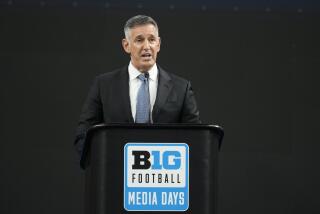NCAA Conference Shakeups: Look for More
That relatively new and dollar-oriented college sport, conference musical chairs, is in the midst of an extended break. But once the major players gather in Nashville, Tenn., this week, there is reason to believe the action will pick up.
The various reform packages under discussion at the NCAA Convention and their ultimate fate will determine the direction for a number of Division I programs. Some are overextended and attempting to retrench. Others are gauging the angles to see where they can reap more dividends.
One of the big wait-and-see items is the Southeastern Conference’s attempt to set up a football playoff, now that it has the required 12 teams for a two-division setup with the addition of Arkansas and South Carolina.
The NCAA regulation governing such playoffs was designed with Division I-AA in mind, but if it is approved for I-A and the TV wise men come bearing lucrative gifts, other leagues could be tempted to grow up to such possibilities.
It is significant that the Big Ten has retained its name, despite Penn State’s new status as member No. 11. Unless the fellowship is planning to boot out noncompetitive Northwestern, there could be a move afoot to expand to 12, with Nebraska prominently mentioned.
The Big Eight and Southwest conferences could unite their slipping forces for another 12-team organization. Although the Pacific-10 insists it is happy with 10 teams, it would have no trouble reaching the magic 12 by picking up Brigham Young and Colorado.
A lot depends on whether TV will view a conference playoff as a major new item or will consider it merely another regional matchup in an ever-longer season.
However, if the College Football Association’s television contracts with ABC and ESPN are overturned, as the Federal Trade Commission has proposed, it could set off a flurry of individual conference deals. That scenario could trigger fresh moves to build strength for the negotiations.
Schools that maintained independent football programs while placing other sports under a conference banner suddenly have moved toward the security of shared revenues.
A good example is Miami, which earned almost $15 million over the last five years from football bowls. The Hurricanes chose to move into the Big East, which agreed to take only 10 percent of Miami’s football revenues while offering annual basketball payoffs of $750,000 or more to a program that lost $285,000 last year.
“Our football has way too much financial pressure on it,” Athletic Director Sam Jankovich said as he negotiated the hookup in his final act before heading to the NFL as general manager of the New England Patriots. “We have been relying far too much on a January 1 bowl bid.”
The other Big East members with I-A football programs -- Syracuse, Pittsburgh and Boston College -- had been looking toward all-sports conferences, and the Big East was happy to get Miami. Now, if the Big East is able to sign up two or more schools from among its invited four -- Virginia Tech, West Virginia, Temple and Rutgers -- as football-only associates, it will have buried a major concern.
It was Penn State’s decision to join the Big Ten 13 months ago that triggered the upheaval.
More to Read
Go beyond the scoreboard
Get the latest on L.A.'s teams in the daily Sports Report newsletter.
You may occasionally receive promotional content from the Los Angeles Times.










